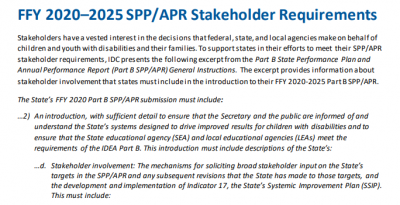
Resource Library
Guides. Briefs. Toolkits. Quick reference information. IDC and its partners created these data quality resources to help states better prepare to address their existing or emerging IDEA data quality needs. Use our search and filtering tools to navigate the library.
Resources 57 - 63 of 88
Format: Guides and Briefs
FFY 2020–25 Part B SPP/APR Changes at a GlanceThe FFY 2020–25 Part B SPP/APR Changes at a Glance resource is a quick overview for tracking updates to indicators in the new FFY 2020–25 SPP/APR package. For each of the 17 SPP/APR indicators, the table denotes whether there will be no changes, minor changes and/or clarifications, changes to response rates and representativeness, changes to data sources, and new components.
Format: Quick Reference
FFY 2020-2025 SPP/APR Stakeholder RequirementsThe FFY 2020-2025 SPP/APR shares the stakeholder requirements for the FFY 2020-2025 SPP/APR in a simple one page format. This resource can be used with state staff and other partners when planning for the SPP/APR.
Format: Quick Reference
FFY 2020–2025 SPP/APR Resources At-a-GlanceThe FFY 2020–2025 SPP/APR Resources At-a-Glance is a list of resources from OSEP and IDC that states can use to support their understanding and actions related to the FFY 2020–2025 Part B SPP/APR.
This video on Exiting details how students with disabilities exit special education (e.g., graduate, drop out, reach the maximum age for services in the state). This is one of a series of videos that provide high-level introductions to the data states must report as part of Section 618 of IDEA.
Format: Guides and Briefs
Examining Representation and Identification: Over, Under, or Both?Significant disproportionality with regard to identifying children as children with disabilities or as children with specific disabilities is, by definition, overrepresentation. This resource defines overrepresentation and three related terms: over-identification, under-identification, and underrepresentation. States can use this resource, in conjunction with the Success Gaps Toolkit to help identify and address the factors contributing to significant disproportionality (i.e., overrepresentation) within school districts.
Format: Applications and Spreadsheets
Equity Requirements in IDEAThis resource compares the three equity requirements in IDEA (disproportionate representation, significant discrepancy, and significant disproportionality) across various elements to explain the similarities and the differences among the requirements.
Format: Applications and Spreadsheets
Educational Environments Ages 3-5: B6 Reporting Tools 2017-2018 Clarifications and Interactive ApplicationThe Reporting Educational Environments resource has been updated with 2017-18 clarifications. State data managers, 619 coordinators, local 619 personnel, technical assistance providers, and other interested parties can use the resource to help with reporting Educational Environments data for children ages 3-5 with disabilities as required for the OSEP Child Count and SPP/APR Indicator 6. States can use the resource's materials as “standalone” tools or as a set.








